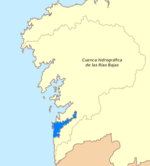Moaña

Moaña is a municipality of 18,709 inhabitants located in Galicia, Spain in the province of Pontevedra. It is one of the five municipalities with Bueu, Cangas do Morrazo, Marin and Vilaboa that forms the peninsula of O Morrazo. This peninsula separates the Ria of Vigo from the Ria of Pontevedra. The coast of Moaña has several beaches and the area combines tourism with traditional seafood production. The surrounding sea contains sea farms where mussels, oysters and other species are cultivated and it is an idyllic place for practicing sea sports activities. The Strait of Rande, where the Rande Bridge now connects Moaña with the municipality of Redondela, was the scene of the Battle of Vigo Bay (or Battle of Rande). Moaña has developed a significant cultural life with the highlights of this being the Interceltic Festival of Morrazo, the Week of Carnival and numerous other local feasts. Social movements were relevant in Moaña in the first half of the 20th century where the presence of the CNT (National Confederation of Labour) was significant. In fact, the current local pub/bar for retired people was the head office of this syndicate in Moaña during the Second Spanish Republic.
Excerpt from the Wikipedia article Moaña (License: CC BY-SA 3.0, Authors, Images).Moaña
Geographical coordinates (GPS) Address Nearby Places Show on map
Geographical coordinates (GPS)
| Latitude | Longitude |
|---|---|
| N 42.283333333333 ° | E -8.75 ° |
Address
36954
Galicia, Spain
Open on Google Maps









